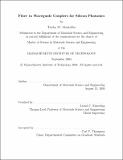Fiber to waveguide couplers for silicon photonics
Author(s)
Montalbo, Trisha M., 1980-
DownloadFull printable version (503.8Kb)
Other Contributors
Massachusetts Institute of Technology. Dept. of Materials Science and Engineering.
Advisor
Lionel C. Kimerling.
Terms of use
Metadata
Show full item recordAbstract
As silicon photonics enters mainstream technology, we find ourselves in need of methods to seamlessly transfer light between the optical fibers of global scale telecommunications networks and the on-chip waveguides used for signal routing and processing in local computing networks. Connecting these components directly results in high loss from their unequal sizes. Therefore, we employ a coupler, which acts as an intermediary device to reduce loss through mode and index matching, and provide alignment tolerance. This thesis presents a potential fiber-to-waveguide coupler design for use in integrating such networks. A quadratic index stack focuses incident light from a fiber in one plane, while a planar lens and linear taper do likewise in the perpendicular plane. Once the mode is sufficiently compressed, the light then enters and propagates through the waveguide. We performed simulations using the beam propagation method and finite difference time domain, among other modeling techniques, to optimize coupling efficiency and gain an understanding of how varying certain parameters affects coupler performance. The simulation results were then incorporated into a mask layout for fabrication and measurement.
Description
Thesis (S.M.)--Massachusetts Institute of Technology, Dept. of Materials Science and Engineering, 2004. This electronic version was submitted by the student author. The certified thesis is available in the Institute Archives and Special Collections. Includes bibliographical references (p. 75-78).
Date issued
2004Department
Massachusetts Institute of Technology. Department of Materials Science and EngineeringPublisher
Massachusetts Institute of Technology
Keywords
Materials Science and Engineering.